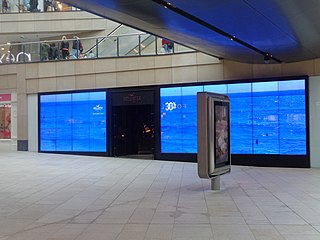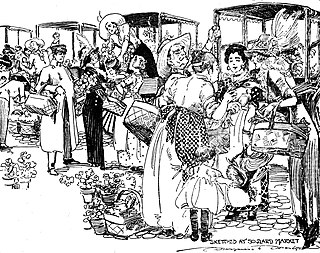
An original equipment manufacturer (OEM) is a company that produces parts and equipment that may be marketed by another company. However, the term is ambiguous, with several other common meanings: an OEM can be the maker of a system that includes other companies' subsystems, an end-product producer, an automotive part that is manufactured by the same company that produced the original part used in the automobile's assembly, or a value-added reseller.

Sales are activities related to selling or the number of goods sold in a given targeted time period. The delivery of a service for a cost is also considered a sale. A period during which goods are sold for a reduced price may also be referred to as a "sale".

Retail is the sale of goods and services to consumers, in contrast to wholesaling, which is the sale to business or institutional customers. A retailer purchases goods in large quantities from manufacturers, directly or through a wholesaler, and then sells in smaller quantities to consumers for a profit. Retailers are the final link in the supply chain from producers to consumers.

3dfx Interactive, Inc. was an American computer hardware company headquartered in San Jose, California, founded in 1994, that specialized in the manufacturing of 3D graphics processing units, and later, video cards. It was a pioneer in the field from the late 1990s to 2000.
In marketing jargon, product lining refers to the offering of several related products for individual sale. Unlike product bundling, where several products are combined into one group, which is then offered for sale as a units, product lining involves offering the products for sale separately. A line can comprise related products of various sizes, types, colors, qualities, or prices. Line depth refers to the number of subcategories under a category. Line consistency refers to how closely related the products that make up the line are. Line vulnerability refers to the percentage of sales or profits that are derived from only a few products in the line.

Pricing is the process whereby a business sets and displays the price at which it will sell its products and services and may be part of the business's marketing plan. In setting prices, the business will take into account the price at which it could acquire the goods, the manufacturing cost, the marketplace, competition, market condition, brand, and quality of the product.

Service economy can refer to one or both of two recent economic developments:
Market penetration refers to the successful selling of a good or service in a specific market. It involves using tactics that increase the growth of an existing product in an existing market. It is measured by the amount of sales volume of an existing good or service compared to the total target market for that product or service. Market penetration is the key for a business growth strategy stemming from the Ansoff Matrix (Richardson, M., & Evans, C.. H. Igor Ansoff first devised and published the Ansoff Matrix in the Harvard Business Review in 1957, within an article titled "Strategies for Diversification". The grid/matrix is utilized across businesses to help evaluate and determine the next stages the company must take in order to grow and the risks associated with the chosen strategy. With numerous options available, this matrix helps narrow down the best fit for an organization.

Rebranding is a marketing strategy in which a new name, term, symbol, design, concept or combination thereof is created for an established brand with the intention of developing a new, differentiated identity in the minds of consumers, investors, competitors, and other stakeholders. Often, this involves radical changes to a brand's logo, name, legal names, image, marketing strategy, and advertising themes. Such changes typically aim to reposition the brand/company, occasionally to distance itself from negative connotations of the previous branding, or to move the brand upmarket; they may also communicate a new message a new board of directors wishes to communicate.
A contract manufacturer (CM) is a manufacturer that contracts with a firm for components or products. It is a form of outsourcing. A contract manufacturer performing packaging operations is called copacker or a contract packager. Brand name companies focus on product innovation, design and sales, while the manufacturing takes place in independent factories.
Electronics manufacturing services (EMS) is a term used for companies that design, manufacture, test, distribute, and provide return/repair services for electronic components and assemblies for original equipment manufacturers (OEMs). The concept is also referred to as electronics contract manufacturing (ECM).

A business can use a variety of pricing strategies when selling a product or service. To determine the most effective pricing strategy for a company, senior executives need to first identify the company's pricing position, pricing segment, pricing capability and their competitive pricing reaction strategy. Pricing strategies and tactics vary from company to company, and also differ across countries, cultures, industries and over time, with the maturing of industries and markets and changes in wider economic conditions.
In marketing, a customer value proposition (CVP) consists of the sum total of benefits which a vendor promises a customer will receive in return for the customer's associated payment.
Value-based price, also called value-optimized pricing or charging what the market will bear, is a market-driven pricing strategy which sets the price of a good or service according to its perceived or estimated value. The value that a consumer gives to a good or service, can then be defined as their willingness to pay for it or the amount of time and resources they would be willing to give up for it. For example, a painting may be priced at a higher cost than the price of a canvas and paints. If set using the value-based approach, its price will reflect factors such as age, cultural significance, and, most importantly, how much benefit the buyer is deriving. Owning an original Dalí or Picasso painting elevates the self-esteem of the buyer and hence elevates the perceived benefits of ownership.
In marketing, a company’s value proposition is the full mix of benefits or economic value which it promises to deliver to the current and future customers who will buy their products and/or services. It is part of a company's overall marketing strategy which differentiates its brand and fully positions it in the market. A value proposition can apply to an entire organization, parts thereof, customer accounts, or products and services.

A brand is a name, term, design, symbol or any other feature that distinguishes one seller's good or service from those of other sellers. Brands are used in business, marketing, and advertising for recognition and, importantly, to create and store value as brand equity for the object identified, to the benefit of the brand's customers, its owners and shareholders. Brand names are sometimes distinguished from generic or store brands.
Eastman Kodak Co. v. Image Technical Servs., Inc., 504 U.S. 451 (1992), is a 1992 Supreme Court decision in which the Court held that even though an equipment manufacturer lacked significant market power in the primary market for its equipment—copier-duplicators and other imaging equipment—nonetheless, it could have sufficient market power in the secondary aftermarket for repair parts to be liable under the antitrust laws for its exclusionary conduct in the aftermarket. The reason was that it was possible that, once customers were committed to the particular brand by having purchased a unit, they were "locked in" and no longer had any realistic alternative to turn to for repair parts.
Clevo is a Taiwanese OEM/ODM computer manufacturer that produces laptop computers. They sell barebones laptop chassis (barebooks) to value-added resellers who build customized laptops for individual customers.

Service parts pricing refers to the aspect of service lifecycle management that deals with setting prices for service parts in the after-sales market. Like other streams of pricing, service parts pricing is a scientific pursuit aimed at aligning service part prices internally to be logical and consistent, and at the same time aligning them externally with the market. This is done with the overarching aim of extracting the maximum possible price from service parts and thus maximize the profit margins. Pricing analysts have to be cognizant of possible repercussions of pricing their parts too high or too low in the after-sales market; they constantly have to strive to get the prices just right towards achieving maximum margins and maximum possible volumes.
Product strategy defines the high-level plan for developing and marketing a product, how the product supports the business strategy and goals, and is brought to life through product roadmaps. A product strategy describes a vision of the future with this product, the ideal customer profile and market to serve, go-to-market and positioning (marketing), thematic areas of investment, and measures of success. A product strategy sets the direction for new product development. Companies utilize the product strategy in strategic planning and marketing to set the direction of the company's activities. The product strategy is composed of a variety of sequential processes in order for the vision to be effectively achieved. The strategy must be clear in terms of the target customer and market of the product in order to plan the roadmap needed to achieve strategic goals and give customers better value.









